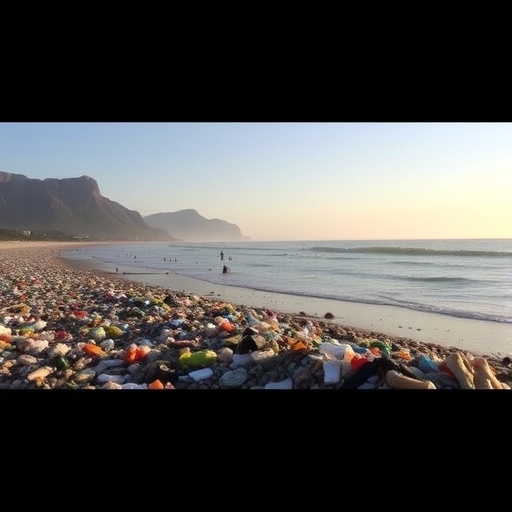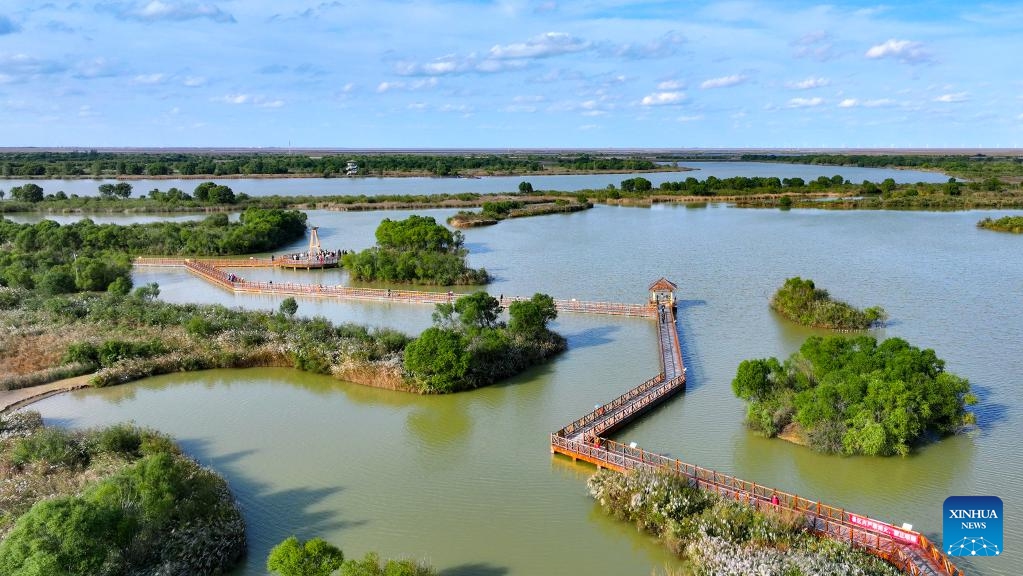Metals Linked to Beach Plastic at South Africa Sites – Bioengineer.org

Report on Metallic Contamination of Beach Plastic Litter in Table Bay, South Africa
Introduction: A Dual Threat to Sustainable Development
A 2025 study by Awe, Oputu, Aigbe, et al., published in Microplastics and Nanoplastics, reports significant metallic contamination of plastic litter on the coastlines of Table Bay, South Africa. The research highlights a critical environmental challenge that directly impedes progress toward several Sustainable Development Goals (SDGs). By demonstrating that beach plastics act as vectors for toxic heavy metals, the study reveals a synergistic threat to marine ecosystems, human health, and the sustainability of coastal communities.
Key Findings and Environmental Impact
Evidence of Contamination
The investigation focused on two specific sites, Woodbridge Island and Derdesteen, revealing that plastic debris is not inert but serves as a sink and transport mechanism for hazardous metals.
- Detected Metals: High concentrations of lead, cadmium, chromium, and nickel were identified on plastic samples.
- Safety Thresholds: The levels of these metals frequently surpassed established environmental safety limits.
- Mechanism: The physicochemical properties of plastic polymers facilitate the adsorption of metals from the marine environment, creating a dual pollution threat.
Advanced Analytical Approach
The study utilized state-of-the-art analytical techniques to provide a precise characterization of the contamination, enabling accurate risk assessment.
- Inductively Coupled Plasma Mass Spectrometry (ICP-MS) was used for the quantitative analysis of metal concentrations.
- Scanning Electron Microscopy (SEM) allowed for the microscale examination of metal-plastic interactions.
Implications for Sustainable Development Goals (SDGs)
SDG 14: Life Below Water
The findings present a severe threat to marine and coastal ecosystems, directly undermining the objectives of SDG 14.
- Ecosystem Degradation: The presence of toxic metals exacerbates the physical harm caused by plastic pollution, threatening marine biodiversity.
- Food Web Contamination: As plastics fragment into microplastics and nanoplastics, they are ingested by marine organisms, introducing heavy metals into the food web. This leads to bioaccumulation and biomagnification, impacting species from plankton to fish.
SDG 3: Good Health and Well-being
The contamination of marine environments poses a direct risk to human health, challenging the core principles of SDG 3.
- Food Safety: The accumulation of metals in fish and shellfish, which are consumed by humans, creates a pathway for toxic substances to enter the human body, endangering public health.
- Chemical Hazards: The study underscores the interconnectedness of environmental pollution and human well-being, highlighting a chemical hazard in addition to the physical threat of plastic.
SDG 6, 11, and 12: Clean Water, Sustainable Cities, and Responsible Consumption
The research links the pollution nexus to land-based activities, emphasizing the need for systemic changes in line with SDGs 6, 11, and 12.
- Water Quality (SDG 6): Metal-laden plastics contribute to the chemical pollution of coastal waters, compromising water quality.
- Urban and Industrial Sources (SDG 11): The pollution originates from anthropogenic pressures, including urban runoff and industrial discharges, pointing to failures in waste management within coastal communities.
- Consumption Patterns (SDG 12): The issue is rooted in unsustainable production and consumption patterns, highlighting the urgent need for source reduction and improved waste management technologies.
Recommendations for Policy and Future Action
Integrated Management Strategies
To effectively address this compounded environmental issue and advance the SDGs, a multi-faceted approach is required.
- Holistic Policies: Remediation efforts must target both physical (plastic) and chemical (metal) pollutants simultaneously, challenging the traditional separation of these issues.
- Source Reduction: Stricter regulations on industrial discharges and improved urban waste management are critical to prevent both plastics and metals from entering marine systems.
- Localized Action: Given that hydrodynamic conditions can concentrate polluted plastics in specific areas, localized pollution management and cleanup operations are essential.
Advancing Research and Monitoring
The study calls for further scientific inquiry to inform effective mitigation strategies, aligning with SDG 17 (Partnerships for the Goals).
- Comprehensive Monitoring: Monitoring programs must incorporate both physical and chemical analyses of plastic debris to understand pollution dynamics fully.
- Interdisciplinary Research: Further investigation is needed to understand the long-term ecological impacts and fate of metal-contaminated plastics in diverse coastal environments globally.
1. SDGs Addressed in the Article
SDG 3: Good Health and Well-being
- The article connects marine pollution directly to human health. It states that heavy metals like lead and cadmium found on plastics are “notorious for their deleterious effects on both marine and human health.” It further warns that these metals can enter the human food chain through the consumption of contaminated seafood, which “endangers food safety and public health.”
SDG 6: Clean Water and Sanitation
- The research focuses on the contamination of coastal waters in Table Bay. The article discusses how plastics act as “sinks and vectors for toxic metals” in the marine environment, degrading water quality. It identifies sources of this pollution as “urban runoff, industrial discharges, and maritime operations,” all of which impact the cleanliness of water bodies.
SDG 11: Sustainable Cities and Communities
- The article highlights that the studied beaches are “exposed to significant anthropogenic pressures” and that “increasing urbanization and industrial activities has exacerbated pollution inputs.” This points to the environmental impact of cities on coastal areas. The call for “improved waste management” and addressing “urban runoff” directly relates to the sustainable management of urban environments.
SDG 12: Responsible Consumption and Production
- The core issue is plastic litter, a product of unsustainable consumption and production patterns. The article implicitly critiques the lifecycle of plastics and chemicals by discussing the need for “source reduction” and “stricter industrial regulations.” It calls for the “environmentally sound management of chemicals and all wastes,” which is a central theme of SDG 12.
SDG 14: Life Below Water
- This is the most prominent SDG in the article. The entire study revolves around marine pollution, specifically “plastic litter found along the shores of South Africa’s Table Bay.” The article details the “deleterious effects on marine life and coastal ecosystems,” including the ingestion of microplastics by marine species and the subsequent introduction of toxic metals into the marine food web. The call to protect marine ecosystems from pollution is a central message.
2. Specific SDG Targets Identified
-
SDG Target 3.9
- By 2030, substantially reduce the number of deaths and illnesses from hazardous chemicals and air, water and soil pollution and contamination.
- The article directly addresses this target by identifying hazardous chemicals (lead, cadmium, chromium, nickel) contaminating the coastal environment (water and soil/sand). It explicitly links this contamination to human health risks, stating that the bioaccumulation of these metals in marine life “endangers food safety and public health.”
-
SDG Target 6.3
- By 2030, improve water quality by reducing pollution, eliminating dumping and minimizing release of hazardous chemicals and materials.
- The study’s findings on “alarming levels of metallic contamination associated with plastic litter” in Table Bay’s coastal waters directly relate to this target. The article identifies sources like “industrial discharges” and “urban runoff” that release both plastic waste and hazardous metals into the marine system.
-
SDG Target 11.6
- By 2030, reduce the adverse per capita environmental impact of cities, including by paying special attention to… municipal and other waste management.
- The article connects the pollution to “increasing urbanization” and calls for “improved waste management” and policies to address “urban runoff.” This highlights the need to manage the environmental footprint of cities to prevent pollution of adjacent ecosystems like Table Bay.
-
SDG Target 12.4
- By 2020, achieve the environmentally sound management of chemicals and all wastes throughout their life cycle… and significantly reduce their release to… water and soil in order to minimize their adverse impacts on human health and the environment.
- This target is central to the article’s analysis. The research demonstrates the combined threat of plastic waste and chemical (metal) waste. The call for “remediation efforts… targeting both chemical and physical pollutants simultaneously” and “stricter industrial regulations” aligns perfectly with achieving sound management of waste and chemicals.
-
SDG Target 14.1
- By 2025, prevent and significantly reduce marine pollution of all kinds, in particular from land-based activities, including marine debris and nutrient pollution.
- The article’s entire focus is on marine pollution, specifically “marine debris” (plastic litter) contaminated with chemical pollutants (metals). It identifies the pollution sources as land-based “anthropogenic pressures,” including urban and industrial activities, making it directly relevant to this target.
3. Indicators for Measuring Progress
-
Concentration of Heavy Metals in the Marine Environment
- The article explicitly mentions that the study “employed advanced analytic techniques to quantify the concentration and variety of metals associated with the plastic particles.” Therefore, the concentration of metals like lead, cadmium, chromium, and nickel on plastic debris and in the surrounding water and sediment serves as a direct indicator to measure pollution levels and the effectiveness of mitigation strategies.
-
Density and Volume of Plastic Debris
- The presence of “plastic litter found along the shores” is the foundational problem discussed. While the article doesn’t provide a specific density figure, the amount of plastic litter collected from the beaches is an implied indicator. Progress towards Target 14.1 could be measured by a reduction in the volume, weight, or count of plastic items found per unit area of the beach.
-
Bioaccumulation of Contaminants in Marine Life
- The article implies this indicator by raising concerns about bioaccumulation and biomagnification. It suggests a scenario where “metals on or inside ingested plastics bioaccumulate in marine organisms, subsequently passing on through the trophic levels to fish, shellfish, and eventually humans.” Therefore, measuring the levels of heavy metals in key marine species (like fish and shellfish) from Table Bay would be a critical indicator of the pollution’s impact on the food web and human health.
4. SDGs, Targets, and Indicators Analysis
| SDGs | Targets | Indicators |
|---|---|---|
| SDG 3: Good Health and Well-being | Target 3.9: Substantially reduce deaths and illnesses from hazardous chemicals and water pollution. | Concentrations of toxic metals (lead, cadmium) in marine organisms consumed by humans. |
| SDG 6: Clean Water and Sanitation | Target 6.3: Improve water quality by reducing pollution and minimizing the release of hazardous chemicals. | Measured concentrations of heavy metals and plastic debris in coastal waters. |
| SDG 11: Sustainable Cities and Communities | Target 11.6: Reduce the adverse per capita environmental impact of cities, including waste management. | Volume and mass of plastic litter originating from urban runoff and poor waste management found on coastal beaches. |
| SDG 12: Responsible Consumption and Production | Target 12.4: Achieve environmentally sound management of chemicals and all wastes. | Levels of metallic pollutants associated with plastic waste, indicating the effectiveness of waste and chemical management. |
| SDG 14: Life Below Water | Target 14.1: Prevent and significantly reduce marine pollution of all kinds, including marine debris. | Density of plastic litter on beaches and the concentration of associated metallic contaminants (lead, cadmium, chromium, nickel). |
Source: bioengineer.org
What is Your Reaction?
 Like
0
Like
0
 Dislike
0
Dislike
0
 Love
0
Love
0
 Funny
0
Funny
0
 Angry
0
Angry
0
 Sad
0
Sad
0
 Wow
0
Wow
0



















































.jpg.webp?itok=0ZsAnae9#)























